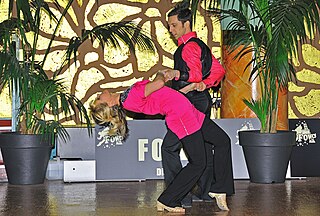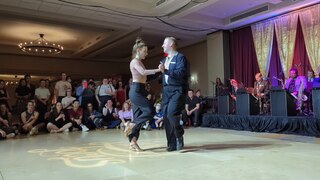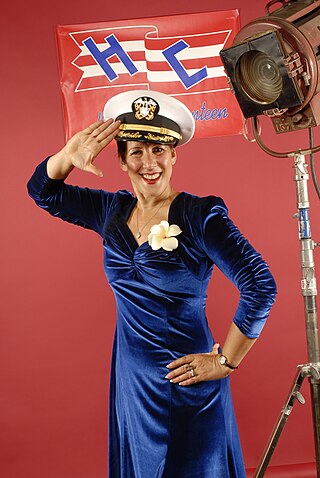Sylvia Sykes is an American swing dancer, instructor, judge, and choreographer. She is known for reviving the swing dance style balboa. [1]
Sylvia Sykes is an American swing dancer, instructor, judge, and choreographer. She is known for reviving the swing dance style balboa. [1]
Sykes and her dance partner Jonathan Bixby started dancing together when she was fourteen years old. They were staff dancers for the television show Shebang during the 1960s. She has studied with many of the dance greats, including Frankie Manning, Dean Collins (1981 to 1984), Maxie Dorf (1984 to 1987), [2] and Willie Desatoff.
Sykes has performed with Count Basie, Glenn Miller, Artie Shaw, and Les Brown. She has appeared on the television shows American Bandstand [3] and Gotta Dance.
She and Bixby represented the U.S. in the World Boogie Woogie Championships in Grenoble, France. She has been head judge for many national swing events as well as being a teacher on how to judge. Following the retirement of Bixby, Sykes taught in Santa Barbara, California, and at workshops around the world including Herräng Dance Camp. In August 2008, she joined Nina Gilkenson and Tena Morales in founding the International Lindy Hop Championships.
She is an inductee into the National Swing Dance Hall of Fame [4] and the California Swing Dance Hall of Fame. [5] She is a U.S. Open champion [6] , was the NASDE top point winner [7] , two time California Balboa Champion, took third place in the National Carolina Shag Dance Championships, and won many Strictly Swing [8] and Jack & Jill dance contests through the U.S. in Lindy Hop [9] , balboa [10] [11] , and West Coast Swing [9] . She was twice voted Swing Dance Teacher of the Year and is a four-time Feather Award winner as Best Female Lindy Dancer or Teacher in the U.S. [1]

Ballroom dance is a set of European partner dances, which are enjoyed both socially and competitively around the world, mostly because of its performance and entertainment aspects. Ballroom dancing is also widely enjoyed on stage, film, and television.

East Coast Swing (ECS) is a form of social partner dance. It belongs to the group of swing dances. It is danced under fast swing music, including: big band, rock and roll, rockabilly, and boogie-woogie.

West Coast Swing is a partner dance with roots in Lindy Hop, characterized by an elastic look that results from its extension-compression technique of partner connection and is danced primarily in a slotted area on the dance floor. The dance allows for both partners to improvise steps while dancing together, putting West Coast Swing in a short list of dances that emphasize improvisation.
An Aerial is a dance move in Lindy Hop or Boogie Woogie where one's feet leave the floor. As opposed to a lift, aerial is a step where a partner needs to be thrown into the air and then landed in time with the music. Each aerial consists of a preparation ('prep'), jump or trick itself and the landing.

Swing dance is a group of social dances that developed with the swing style of jazz music in the 1920s–1940s, with the origins of each dance predating the popular "swing era". Hundreds of styles of swing dancing were developed; those that have survived beyond that era include Charleston, Balboa, Lindy Hop, and Collegiate Shag. Today, the best-known of these dances is the Lindy Hop, which originated in Harlem in the early 1930s. While the majority of swing dances began in African-American communities as vernacular African-American dances, some influenced swing-era dances, like Balboa, developed outside of these communities.
Swing Rueda is a swing dance in the round (wheel) that features someone calling Lindy Hop moves and the dancers moving in unison. It was adapted from Salsa Rueda by Elaine Hewlett and Jeff Miller at The Rhythm Room Dance Studio, Dallas, Texas in 2000.

The Balboa, also known as "Bal" is a swing dance that originated in Southern California during the 1920s and enjoyed huge popularity during the 1930s and 1940s.

Jitterbug is a generalized term used to describe swing dancing. It is often synonymous with the lindy hop dance but might include elements of the jive, east coast swing, collegiate shag, charleston, balboa and other swing dances.

Frank Manning was an American dancer, instructor, and choreographer. Manning is considered one of the founders of Lindy Hop, an energetic form of the jazz dance style known as swing.
Jack and Jill is a format of competition in partner dancing, where the competing couples are the result of random matching of leaders and followers. Rules of matching vary.
Dean Collins was an American dancer, instructor, choreographer, and innovator of swing dance. He is often credited with bringing the Lindy Hop from New York to southern California. Collins worked in over thirty films and performed live and on television.
Jewel McGowan (1921-1962) is best known as a dancer of Lindy Hop, a form of swing dance, in the 1940s and 1950s. She also danced in other, non-swing films, and with modern jazz dance pioneer Jack Cole. She is known among dance aficionados as the frequent partner of dancer Dean Collins. McGowan was considered by her fellow Los Angeles dancers to be the best female swing dancer who ever lived. In addition to their social dancing, Collins and McGowan appeared together as dancers in films of the era. They were partners for 11 years. McGowan is especially known for her hip swivels.
Whitey's Lindy Hoppers was a professional performing group of exceptional swing dancers that was first organized in the late 1920s by Herbert "Whitey" White in the Savoy Ballroom and disbanded in 1942 after its male members were drafted into World War II. The group took on many different forms and had several different names and sub-groups, including Whitey's Hopping Maniacs, Harlem Congeroo Dancers, and The Hot Chocolates. In addition to touring nationally and internationally, the group appeared in several films and Broadway theatre productions. Dorothy Dandridge and Sammy Davis Jr. were among the group's celebrity regulars.

The history of Lindy Hop begins in the African American communities of Harlem, New York during the late 1920s in conjunction with swing jazz. Lindy Hop is closely related to earlier African American vernacular dances but quickly gained its own fame through dancers in films, performances, competitions, and professional dance troupes. It became especially popular in the 1930s with the upsurge of aerials. The popularity of Lindy Hop declined after World War II, and it converted to other forms of dancing, but it never disappeared during the decades between the 1940s and the 1980s until European and American dancers revived it starting from the beginning of the 1980s.
The Canadian Swing Championships commonly known as CSC is an annual event held since 2002 to showcase swing dancing Canada. It is held near Montreal during Victoria Day weekend. Before 2005, the event was called the Eastern Canadian Swing Championship, but it was renamed when no equivalent event was started in Western Canada and the ECSC became the de facto national championship.
St. Louis shag is a swing dance that evolved from the Lindy Hop, Collegiate Shag and Charleston. It is a fast, closed position dance that is usually done to stomp, jump, and boogie-woogie music.

Rusty Frank is an American tap dancer, producer, writer, choreographer, lindy hopper, and dance preservationist.

The Lindy Hop is an American dance which was born in the African-American communities of Harlem, New York City, in 1928 and has evolved since then. It was very popular during the swing era of the late 1930s and early 1940s. Lindy is a fusion of many dances that preceded it or were popular during its development but is mainly based on jazz, tap, breakaway, and Charleston. It is frequently described as a jazz dance and is a member of the swing dance family.